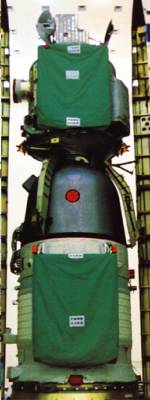The watershed events of Mao's death in 1976 and Dong Xiaoping's rise to power in 1978 brought many changes in China. The development of the China's space program slowed and some military missile projects were cancelled. But the space program recovered from the slow down and new projects were launched.
In 1978, the first Yuanwang class space craft tracking vessel was commissioned and built followed by a second in 1979 . The name means "Long View." This class of ships is dedicated to tracking launches of missiles and satellites. For the first time, these ships allowed China to track launches that were taking place outside of China.
The Long March 1 rockets that launched China's first satellites in 1970 and 1974 were followed by the Long March 2 flew in the 1970s on reconnaissance missions. In 1982 and 1983, the Long March 2C was developed and successfully launched again for reconnaissance. Throughout the rest of the 1980s, Long March 2C rockets were launched for reconnaissance missions.
In 1984, the Chinese launched the Long March 3 rocket to place China's first geosynchronous satellite, Chinasat-1. In 1985, the Chinese began making the Long March 3 rocket available to launch foreign satellites, primarily for European and Asian countries. In addition, a whole series of Chinasat geosynch communication satellites were launched with Long March 3 rockets.
In 1986, an attempt was made to proceed with the Chinese manned space program. Project 863-2 was an ambitious plan to launch a space station and space craft to bring astronauts to the station. This particular project was never implemented but did lead to other manned launch projects. The Chinese Ministry of Aerospace Industry was founded in 1988.
In the 1990s, the Long March 2 series of rockets continued their launches for reconnaissance and satellites. The Long March 3 rockets continued to launch communication satellites into geosynchronous orbit. Most of the launches were successful although there were occasional failures.
In 1992, authorization and funding was passed for a major manned space flight program called Project 921-2. The plan called for four launches of unmanned capsules and two launches of capsules with crews. The first unmanned launch of the Shenzhou 1 space craft took place in late 1999 powered by the Long March 2F rocket. This sixteen thousand pound craft achieved obit and descended successfully after twenty one hours and fourteen orbits. This was followed by the unmanned Shenzhou 2 in 2001 with several animals about and a number of experiments. The craft orbited for over seven days, completing one hundred and seventeen orbits, the unmanned Shenzhou 3 was the first craft that tested life support for human crew. It was aloft for almost seven days and completed one hundred and seven orbits before descending. The final unmanned mission, the Shenzhou 4 was launched in 2002. It was completely outfitted for a human crew and followed the same mission profile as the Shenzhou 3.
With the successful completion of the four planned unmanned missions, China now stood on the brink of launching human beings into space.
Chinese Shenzhou 4 manned space craft:
